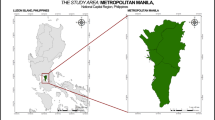Abstract
Impact assessment of watershed development activity assumes greater importance in present day agriculture. Considering the ability of remote sensing technology in watershed monitoring and impact assessment, a study was carried out to investigate the Impact Assessment of Karnataka Watershed Development Project (DANIDA) in Koralahallihalla Sub watershed in Sindagi taluk of Bijapur district in Northern Karnataka using satellite data of two periods i.e., IRS 1 C, LISS-III data of 30 December, 1997 (pre-treatment) and IRS P6, LISS-III data of 17 December, 2004 (post-treatment). The land use/land cover map was derived from the supervised classification. The results revealed that there has been no major shift in cropping patterns over a period of 7 years (1997–2004). However, rabi cropped area has decreased drastically (187 ha), which might be due to the continuous droughts that occurred during the implementation period. On the other hand, kharif and double cropped area have increased marginally (103 ha and 96 ha, respectively). Increase in double cropped area showed that there was increase in irrigated land, which were earlier being used as rainfed and wastelands turned in to cultivated lands as seen in scrub lands and rabi cropped areas of the sub watershed. Wastelands in the sub-watershed has decreased marginally (36 ha). The vegetation vigour of the sub-watershed has been derived from the NDVI maps of both the periods. These NDVI maps indicate that there was a significant change in biomass status of the sub watershed. The vegetation vigour of the area was classified into three classes using NDVI. Substantial increase in the area under high and low biomass levels was observed (319 ha and 77 ha, respectively). The benefit-cost analysis indicates that the use of remote sensing technology was 2 times cheaper than the conventional methods. Thus, the repetitive coverage of the satellite data provides an excellent opportunity to monitor the land resources and evaluate the land cover changes through comparison of images for the watershed at different periods.





Similar content being viewed by others
References
Agnihothri, J., Mittal, S. P., Grewal, S. S., & Mishra, F. R. (1986). Economic evaluation of water resources development in shivalik foothills—a case study. Indian Journal of Soil Conservation, 14(3), 7–14.
Anonymous (1998). Monitoring and evaluation of watersheds in Karnataka using satellite remote sensing. Technical Report, ISRO-NNRMS-TR-98, pp. 5–22.
Arun, Y. S. (1998). Economic evaluation of watershed development—a case study of Kuthanagera micro watershed in Karnataka. PhD thesis, UAS, Bangalore, India.
Dueker, K. J., & Kjerne, D. (1989). Multipurpose cadastre terms and definitions (pp. 122–127). Falls Church: American Society of Photogrammetry and Remote Sensing and American Congress on Surveying and Mapping.
Inoue, Y., Morinaga, S., & Shibayame, M. (1993). Non-destructive estimation of water status on intact crop leaves based on spectral reflectance measurements. Japan Journal of Crop Science, 62, 462–469.
Jaiswal, R. K., Saxena, J., & Mukherjee, S. (1994). Application of remote sensing technology for land use / land cover change analysis. Journal of Indian Society of Remote Sensing, 27(2), 123–128.
Kachhwah, T. S. (1990). Supervised classification approach for assessment of forest resources in part of U.P. plains, India using landsat-3 data. Journal of Indian Society of Remote Sensing, 18(1&2), 9–14.
Kallur, M. S. (1991). Socio-economic impact of Muchkulnal watershed development project, Gulbarga district, Karnataka—a case study of pattern village. Indian Journal of Agricultural Economics, 46(3), 314–317.
Kant, Y., & Badarinath, K. V. S. (1989). Regional and evapotranspiration estimation using satellite derived albedo and surface temperature. Journal of Indian Society of Remote Sensing, 26(3), 129–134.
Lillesand, M. T., & Kiefer, W. R. (2000). Remote sensing and image interpretation. New York: Wiley. ISBN No. 0-471-57783-9.
Liu, W. T., & Negron Juarez, R. I. (2001). ENSO drought onset prediction in north-east Brazil using NDVI. International Journal of Remote Sensing, 22, 3483–3501.
Lu, D., Mausel, P., Batistella, M., & Moran, E. (2003). Comparison of land-cover classification methods in the Brazilian Amazon basin, Proceedings of ASPRS Annual Conference, May 2003, Anchorage, Alaska.
Patel, N. R., Mehta, A. N., & Shekh, A. M. (2001). Canopy temperature and water stress quantification in rainfed pigeonpea (Cajanus cajana L.). Agriculture and Forest Meteorology, 109, 614–621.
Randhir, O., & Ravichandran, M. (1991). Economic analysis of watershed management in Anakatti region of Coimbatore district through national perspective. Indian Journal of Agricultural Economics, 46(3), 301–307.
Rao, B. R. M., Rao, P. V. N., Thimmappa, S. S., & Fyzee, M. A. (1998). ERS-1 SAR response and land features and its suitability for soil moisture estimation presented at the first European conference on space week, November 22–27, 1998, Singapore.
Sabins, F. F. (2000). Remote sensing principles and interpretations. New York: W.H. Freeman and Company.
Schmidt, K. S., & Skidmore, A. K. (2001). Exploring spectral discrimination of grass species in African range lands. International Journal of Remote Sensing, 22, 3421–3434.
Seto, K. C., Wood Cock, C. E., Song, S., Hung, X., Lu, J., & Kautmann, R. K. (2002). Monitoring of land use change in the Pearl River Delta using landsat TM. International Journal of Remote Sensing, 23(10), 1985–2004.
Singh, K., Sandhu, H. S., & Singh, N. (1989). Socio-economic impact of Kandi watershed and area development project in Punjab. Indian Journal of Agricultural Economics, 44(3), 282–283.
Wentzel, K. (2002). Determination of the overall soil erosion potential in the Nsikazi district (Mpumalanga Province, South Africa) using remote sensing and GIS. Canadian Journal of Remote Sensing, 28(2), 322–327.
Acknowledgement
The authors are very much thankful to the staff of Department of Agriculture, Bijapur district for their valuable help and cooperation extended during the study period.
Author information
Authors and Affiliations
Corresponding author
About this article
Cite this article
Shanwad, U.K., Gowda, H.H., Prabhuraj, D.K. et al. Impact Assessment of Watershed Programme Through Remote Sensing and Geographical Information System. J Indian Soc Remote Sens 40, 619–628 (2012). https://doi.org/10.1007/s12524-011-0170-7
Received:
Accepted:
Published:
Issue Date:
DOI: https://doi.org/10.1007/s12524-011-0170-7




